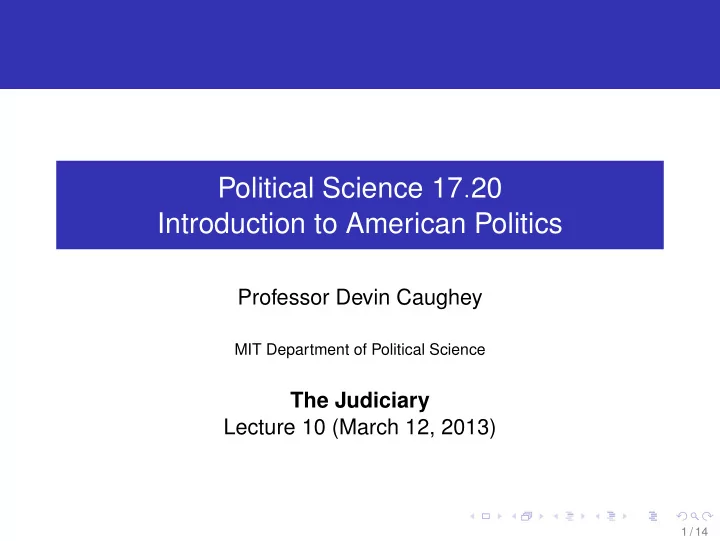

Political Science 17 . 20 Introduction to American Politics Professor Devin Caughey MIT Department of Political Science The Judiciary Lecture 10 (March 12, 2013) 1 / 14
Outline The Judiciary in a Democracy 1 Judicial Decision Making 2 3 Judicial Decision Making in Practice 2 / 14
Outline The Judiciary in a Democracy 1 Judicial Decision Making 2 3 Judicial Decision Making in Practice 3 / 14
The Role of the Federal Judiciary Supreme Court ↑ Appellate Courts (regional circuit courts) ↑ Trial Courts (district courts, etc.) Responsibility: Interpret, reconcile, and apply the law → judicial review (strike down laws as unconstitutional) 4 / 14
Judicial Review Over Time Judicial Jurisdiction: Marbury v. Madison (1803) Slavery: Dred Scott v. Sandford (1857) Property Rights: Lochner v. New York (1905) Civil Rights: Brown v. Board of Education of Topeka (1954) Privacy Rights: Roe v. Wade (1973) Federalism: Nat’l Fed. of Ind. Business v. Sebelius (2012) → Medicaid expansion infringed on states’ rights. → But individual mandate valid under Congress’s taxation (not commerce) power. 5 / 14
The Countermajoritarian Difficulty How can judicial review, which involves appointed judges nullifying the decisions of democratically elected officials, be justified in a democracy? Umpire in constitutional system Protector of the rights of minorities and powerless Guardian of democratic processes Is the countermajoritarian difficulty really a problem in practice? 6 / 14
Outline The Judiciary in a Democracy 1 Judicial Decision Making 2 3 Judicial Decision Making in Practice 7 / 14
What Motivates Judges? Unlike members of Congress, federal judges do not have to worry about reelection. So how to they decide cases? One answer is legal considerations: Facts of the case Text of the constitution/statute Legislative intent Precedent ( stare decisis ) Legal model has historically dominated legal education 8 / 14
The Attitudinal Model There is often no single “correct” decision or “neutral” set of criteria → inherently subjective Different judges come to different conclusions on the law based on their sincere policy preferences. 9 / 14
Judges as Strategic Political Actors Strategic Model: Judges are motivated by policy goals but are constrained in a number of ways. Institutional and professional legitimacy Public opinion Reaction of other branches Capacity to implement decisions 10 / 14
Outline The Judiciary in a Democracy 1 Judicial Decision Making 2 3 Judicial Decision Making in Practice 11 / 14
Multiple Motivations Empirically, judges seem to motivated by a number of considerations, but they also tend to line up ideologically like members of Congress do. 12 / 14
Countermajoritarian Decisions Are Rare Judiciary rarely out of line with dominant political coalition Federal judges typically strike down state laws. Nonmajoritarian difficulty: Dominant coalition may be unable or unwilling to decide Clashing majorities Abortion: difficult cross-cutting issue for both parties 13 / 14
Implementing Judicial Decisions Marbury v. Madison was unusual in that it was self-implementing. By contrast, most exercises of judicial review involve getting other political institutions (cities, states, the president) to do something. Abortion vs. civil rights 14 / 14
MIT OpenCourseWare http://ocw.mit.edu 17.20 Introduction to American Politics Spring 2013 For information about citing these materials or our Terms of Use, visit: http://ocw.mit.edu/terms .
Recommend
More recommend